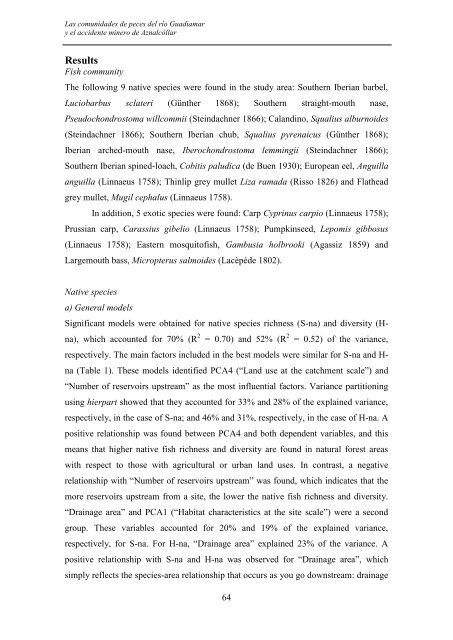las comunidades de peces del río guadiamar y el accidente minero ...
las comunidades de peces del río guadiamar y el accidente minero ...
las comunidades de peces del río guadiamar y el accidente minero ...
Create successful ePaper yourself
Turn your PDF publications into a flip-book with our unique Google optimized e-Paper software.
Las <strong>comunida<strong>de</strong>s</strong> <strong>de</strong> <strong>peces</strong> <strong>de</strong>l <strong>río</strong> Guadiamar<br />
y <strong>el</strong> acci<strong>de</strong>nte <strong>minero</strong> <strong>de</strong> Aznalcóllar<br />
Results<br />
Fish community<br />
The following 9 native species were found in the study area: Southern Iberian barb<strong>el</strong>,<br />
Luciobarbus sclateri (Günther 1868); Southern straight-mouth nase,<br />
Pseudochondrostoma willcommii (Steindachner 1866); Calandino, Squalius alburnoi<strong>de</strong>s<br />
(Steindachner 1866); Southern Iberian chub, Squalius pyrenaicus (Günther 1868);<br />
Iberian arched-mouth nase, Iberochondrostoma lemmingii (Steindachner 1866);<br />
Southern Iberian spined-loach, Cobitis paludica (<strong>de</strong> Buen 1930); European e<strong>el</strong>, Anguilla<br />
anguilla (Linnaeus 1758); Thinlip grey mullet Liza ramada (Risso 1826) and Flathead<br />
grey mullet, Mugil cephalus (Linnaeus 1758).<br />
In addition, 5 exotic species were found: Carp Cyprinus carpio (Linnaeus 1758);<br />
Prussian carp, Carassius gib<strong>el</strong>io (Linnaeus 1758); Pumpkinseed, Lepomis gibbosus<br />
(Linnaeus 1758); Eastern mosquitofish, Gambusia holbrooki (Agassiz 1859) and<br />
Largemouth bass, Micropterus salmoi<strong>de</strong>s (Lacèpé<strong>de</strong> 1802).<br />
Native species<br />
a) General mo<strong>de</strong>ls<br />
Significant mo<strong>de</strong>ls were obtained for native species richness (S-na) and diversity (Hna),<br />
which accounted for 70% (R 2 = 0.70) and 52% (R 2 = 0.52) of the variance,<br />
respectiv<strong>el</strong>y. The main factors inclu<strong>de</strong>d in the best mo<strong>de</strong>ls were similar for S-na and H-<br />
na (Table 1). These mo<strong>de</strong>ls i<strong>de</strong>ntified PCA4 (“Land use at the catchment scale”) and<br />
“Number of reservoirs upstream” as the most influential factors. Variance partitioning<br />
using hierpart showed that they accounted for 33% and 28% of the explained variance,<br />
respectiv<strong>el</strong>y, in the case of S-na; and 46% and 31%, respectiv<strong>el</strong>y, in the case of H-na. A<br />
positive r<strong>el</strong>ationship was found between PCA4 and both <strong>de</strong>pen<strong>de</strong>nt variables, and this<br />
means that higher native fish richness and diversity are found in natural forest areas<br />
with respect to those with agricultural or urban land uses. In contrast, a negative<br />
r<strong>el</strong>ationship with “Number of reservoirs upstream” was found, which indicates that the<br />
more reservoirs upstream from a site, the lower the native fish richness and diversity.<br />
“Drainage area” and PCA1 (“Habitat characteristics at the site scale”) were a second<br />
group. These variables accounted for 20% and 19% of the explained variance,<br />
respectiv<strong>el</strong>y, for S-na. For H-na, “Drainage area” explained 23% of the variance. A<br />
positive r<strong>el</strong>ationship with S-na and H-na was observed for “Drainage area”, which<br />
simply reflects the species-area r<strong>el</strong>ationship that occurs as you go downstream: drainage<br />
64

















